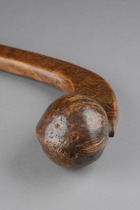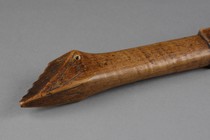Ball-head war club, late 18th century · North America, Woodlands, Ojibwa · ID: 3040325
Description
made from the extremely hard and dense wood from the root ball of a maple sapling, transition point of shaft and club head carved to suggest a zoomorphic creature holding a ball in its jaw, shaft with symbolic scratched drawings, bevelled end and grooved rim, drilled hole for buckskin thong, slightly dam., minor missing parts and fine cracks at the club head, abrasion of paint;
ball-head clubs were the most widely used weapons for close combat in the eastern woodlands of 17th century. The hard wood could smash the skull of an opponent. Drawings incised along one of the flat sides of the shaft represent the war record of the warrior who owned this club: the ten human figures without heads are the enemies he killed and the one carved with a head represents a prisoner. A series of ten groupings of vertical lines represent the number of times the club owner had been to war. According to the records of contemporary witnesses the indigenous warriors used their engraved clubs as a kind of “business card”. They left the club behind them with the dead body, so that the enemies may know who killed their people and what nation he is.
L’objet Ball-head war club, late 18th century numéro d’objet 3040325, a fait partie de l’enchère 82nd Tribal Art Auction en 27 février 2016 pour la dernière fois le Zemanek-Münster Hôtel des ventes et avait le numéro de lot 107.
Vous trouverez ici d’autres objets et des informations utiles sur le thème Art américain.
Littérature comparée
Wieczorek, Alfred u.a. (Hg.), Der Kult um Kopf und Schädel, Mannheim 2011, p. 80, ill. 2 Penney, David W., Indigenous Beauty, New York 2015, ill. 105 Boden, Gertrud, Nordamerika, Köln 1995, ill. 669, 670






